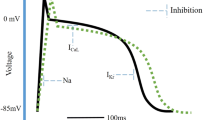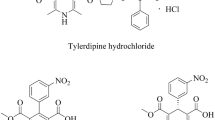Abstract
The aim of this phase I, dose-escalating study was to evaluate the pharmacokinetics, electrocardiographic effect and safety of amiodarone after a single intravenous administration in Japanese subjects. Thirty-two healthy Japanese male volunteers (20–32 years) were randomized to three single-dose groups (1.25, 2.5 and 5.0 mg/kg). In each group, six (1.25 mg/kg) or ten (2.5 and 5.0 mg/kg) subjects received a single 15-min infusion of intravenous amiodarone, and two subjects received glucose solution as control. The pharmacokinetic profile, blood pressure and electrocardiographic analyses were obtained on a timely basis after up to 77 days. The maximum plasma concentration (C max) and area under the concentration-time curve (AUC0–96) for amiodarone 1.25, 2.5 and 5.0 mg/kg displayed dose-dependent characteristics: mean C max was 2,920 ± 610, 7,140 ± 1,480 and 13,660 ± 3,410 ng/ml, respectively; the mean AUC0-96 was 3,600 ± 700, 8,100 ± 1,600 and 16,600 ± 4,300 ng h/ml, respectively. A long serum half-life (>14 days) was observed for amiodarone and desethylamiodarone. PR intervals were prolonged at 15 min (0.16 ± 0.0.1 vs. 0.15 ± 0.01 s, p = 0.03) and 18 min (0.17 ± 0.01 vs. 0.15 ± 0.01 s, p = 0.03) with the 5.0 mg/kg dose compared with baseline. No other significant changes in electrocardiographic parameters, pulse rate or blood pressure were observed. A needle-pain-induced vasovagal effect appeared in a volunteer, and three volunteers experienced pain at the drug infusion site. After a single infusion of amiodarone at doses of 1.25–5.0 mg/kg, serum concentrations increased in a dose-dependent manner. A single intravenous amiodarone dose barely affected the electrocardiographic parameters and was well tolerated.






Similar content being viewed by others
References
Podrid PJ (1995) Amiodarone: reevaluation of an old drug. Ann Intern Med 122:689–700
Shiga T, Wakaumi M, Imai T, Suzuki T, Hosaka F, Yamada Y, Matsuda N, Shoda M, Sugiura R, Hagiwara N, Kasanuki H (2002) Effect of low-dose amiodarone on atrial fibrillation or flutter in Japanese patients with heart failure. Circ J 66:600–604
Shiga T, Wakaumi M, Matsuda N, Shoda M, Hagiwara N, Sato K, Kasanuki H (2001) Amiodarone-induced thyroid dysfunction and ventricular tachyarrhythmias during long-term therapy in Japan. Jpn Circ J 65:958–960
Yamada Y, Shiga T, Matsuda N, Hagiwara N, Kasanuki H (2007) Incidence and predictors of pulmonary toxicity in Japanese patients receiving low-dose amiodarone. Circ J 71:1610–1616
Suzuki S, Yamashita T, Otsuka T, Sagara K, Uejima T, Oikawa Y, Yajima J, Koike A, Nagashima K, Kirigaya H, Ogasawara K, Sawada H, Yamazaki T, Aizawa T (2009) Treatment strategy and clinical outcomes in Japanese patients with atrial fibrillation. Heart Vessels 24:287–293
Takahashi A, Shiga T, Shoda M, Tanizaki K, Manaka T, Ejima K, Kasanuki H, Hagiwara N (2010) Gender difference in arrhythmic occurrences in patients with nonischemic dilated cardiomyopathy and implantable cardioverter-defibrillator. Heart Vessels 25:150–154
Chow MS (1996) Intravenous amiodarone: pharmacology, pharmacokinetics, and clinical use. Ann Pharmacother 30:637–643
Vadiei K, Troy S, Korth-Bradley J, Chiang ST, Zimmerman JJ (1997) Population pharmacokinetics of intravenous amiodarone and comparison with two-stage pharmacokinetic analysis. J Clin Pharmacol 37:610–617
Roden DM (1993) Pharmacokinetics of amiodarone: implications for drug therapy. Am J Cardiol 72:45F–50F
Vadiei K, O’Rangers EA, Klamerus KJ, Kluger J, Kazierad DJ, Leese PT, Chow MS, Zimmerman JJ (1996) Pharmacokinetics of intravenous amiodarone in patients with impaired left ventricular function. J Clin Pharmacol 36:720–727
Kamiya K, Nishiyama A, Yasui K, Hojo M, Sanguinetti MC, Kodama I (2001) Short- and long-term effects of amiodarone on the two components of cardiac delayed rectifier K(+) current. Circulation 103:1317–1324
Kodama I, Kamiya K, Toyama J (1999) Amiodarone: ionic and cellular mechanisms of action of the most promising class III agent. Am J Cardiol 84:20R–28R
Ikeda N, Nademanee K, Kannan R, Singh BN (1984) Electrophysiologic effects of amiodarone: experimental and clinical observation relative to serum and tissue concentrations. Am Heart J 108:890–898
Desai AD, Chun S, Sung RJ (1997) The role of intravenous amiodarone in the management of cardiac arrhythmias. Ann Intern Med 127:294–303
Morady F, DiCarlo LA Jr, Krol RB, Baerman JM, de Buitleir M (1986) Acute and chronic effects of amiodarone on ventricular refractoriness, intraventricular conduction and ventricular tachycardia induction. J Am Coll Cardiol 7:148–157
Cinelli P, Romano S, Castaldo G, de Scalzi M, Citi S, de Leonardis V (1984) Computerized M-mode echocardiography in the assessment of cardiovascular effects during intravenous administration of amiodarone. Methods Find Exp Clin Pharamcol 6:27–32
Munoz A, Karila P, Gallay P, Zettelmeier F, Messner P, Mery M, Grolleau R (1988) A randomized hemodynamic comparison of intravenous amiodarone with and without Tween 80. Eur Heart J 9:142–148
Remme WJ, Kruyssen HA, Look MP, van Hoogenhuyze DC, Krauss XH (1991) Hemodynamic effects and tolerability of intravenous amiodarone in patients with impaired left ventricular function. Am Heart J 122(1 Pt 1):96–103
Cushing DJ, Adams MP, Cooper WD, Zhang B, Lipicky RJ, Kowey PR (2009) Evaluation of the effects of PM101, a cyclodextrin-based formulation of intravenous amiodarone, on blood pressure in healthy humans. Am J Cardiol 104:1152–1157
Kowey PR, Marinchak RA, Rials SJ, Filart RA (1997) Intravenous amiodarone. J Am Coll Cardiol 29:1190–1198
Acknowledgments
The authors thank Stephanie Blick and Nicola Van Aardt of Wolters Kluwer Health Medical Communications, who provided assistance with the preparation of the manuscript. This study was supported by Taisho-Sanofi Synthelabo Co., Ltd. (Sanofi-Aventis KK, Tokyo, Japan).
Author information
Authors and Affiliations
Corresponding author
Additional information
This article is based on research that was first reported in Japanese by Shiga et al. Progress in Medicine (2008) 28(Suppl 1):667–670.
Rights and permissions
About this article
Cite this article
Shiga, T., Tanaka, T., Irie, S. et al. Pharmacokinetics of intravenous amiodarone and its electrocardiographic effects on healthy Japanese subjects. Heart Vessels 26, 274–281 (2011). https://doi.org/10.1007/s00380-010-0047-7
Received:
Accepted:
Published:
Issue Date:
DOI: https://doi.org/10.1007/s00380-010-0047-7




